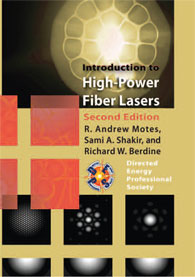Lasers have become pervasive in our daily lives. They are used at checkout counters in supermarkets and department stores to scan barcodes; in home and office copiers, printers, and DVD players; in industrial applications and materials processing involving marking, drilling, cutting, and welding; in science and engineering for precise measurements of distance, temperature, density, fluid velocity, and specie concentrations; in high-speed, high-bandwidth communications; and in imaging and remote-sensing applications. These lasers come in many varieties. Most lasers built into consumer products are small diode lasers, while lasers for industrial applications are typically high-power gas or bulk solid-state lasers (SSLs). On the other hand, fiber lasers—a relatively new technology that is a subclass of solid-state lasers—are growing in popularity for communications and industrial applications. Undoubtedly lasers will find additional applications and become more ubiquitous in the future.
Because of the widespread use of lasers, it is now even more important that engineers, scientists, and technical managers understand all forms of this technology. Several excellent textbooks1–4 are available that describe the theory and operation of lasers in general, but this book specializes in high-power fiber laser (HPFL) technology, beam combination and HPFL systems. Because the technology is relatively new, there is limited HPFL information available in a single place for use in universities for teaching and conducting research and in industry for making technical and managerial decisions. Here we have collected information from literally hundreds of research publications and arranged it in what we hope is a logical format. We have tried to make it useful for students, scientists, engineers, and technical managers. However, it is difficult, if not impossible, to please everyone. Students and scientists typically want to see the derivations while engineers and technical managers usually just want the bottom line. In certain places we show derivations and in others we simply refer the reader to the relevant scientific publication for derivation details. At the end of each chapter we provide a summary of the most important information, so readers interested only in the bottom line can find it there. We hope our approach is a useful compromise of information content that allows for the widest possible dissemination of information about this rapidly maturing technology.
We begin this book with a general introduction to HPFLs. In this introduction, we first discuss the history of these devices and illustrate the recent rapid rate of maturation. Then we answer the question, "Why high-power fiber lasers?" There are other high-power bulk SSLs that are vying for position in industry and defense, so we believe the reader will be interested in learning the advantages of fiber lasers over bulk SSLs. We conclude the general introductory chapter with a discussion of the current state of the art in fiber lasers.
Next we provide a detailed, technical overview of HPFLs, first providing an introduction to optical waveguides in silica glass fibers and then a technical review of fiber amplifiers and lasers. Since no laser is perfect, we also include a chapter on fiber laser limitations. And speaking of limitations, because single-fiber lasers are limited in output power, we also provide chapters on Fourier optics, beam quality, and beam combining. An understanding of these fundamental concepts will hopefully aid in the development and scaling of fiber laser systems past 10 kW with good beam quality.
Because fiber lasers can also be used in pulse mode, this second edition contains a chapter that describes this mode of operation. These pulsed fiber lasers are now becoming widely available for industrial marking and cutting applications.
The second edition also includes two chapters on beam propagation modeling—one for optical waveguides such as optical fiber, and one for free-space or atmospheric beam propagation. Modeling for beam propagation in fiber waveguides and lasers is very useful in the design of microstructured fibers such as those with multiple cores. The free-space beam-propagation simulations are useful in determining the propagation characteristics of fiber array outputs. These fiber array outputs must also be focused for short-range applications, so we have included a chapter on laser beam focusing. Beam-propagation simulations can then be used to predict target irradiance patterns produced by focused array outputs.
We conclude with a chapter on system design considerations and a chapter on applications and future directions. These are important issues when the overall effectiveness of HPFLs is considered. Systems engineers and technical managers will be especially interested in the systems discussion where we consider issues such as performance trades, weight, thermal management, and efficiency. Technical planners may be more interested in the information provided on applications and future directions. Naturally, these last chapters will be less mathematically rigorous.
In summary, we first provide a general introduction to fiber lasers, followed by a detailed technical introduction and top-level information on system design considerations, and then finally a discussion of applications and future directions of HPFLs. We believe this to be a logical approach to understanding HPFLs.
We offer special thanks to two people who have made significant contributions to this edition. Jim Griggs's careful reading of the first edition was very helpful in identifying errors so that we could correct them in this edition. Next, Gabe Mounce was kind enough to review several chapters of the current edition and provided numerous useful recommendations. We also note that our primary reviewer for the first edition of this book, Sami Shakir, has been promoted to author for the second edition due to his significant contribution. Finally, there are contributions from many scientists noted throughout the text that have not only added significantly to the state of the art of fiber laser research today, but who have also generously contributed to this book.
References
- Siegman, A.E., Lasers, University Science Books (1986).
- Verdeyen, J.T., Laser Electronics, 2nd ed., Prentice Hall Series in Solid State Physical Electronics (1989).
- Yariv, A., Optical Electronics, 3rd ed., Holt, Rinehart and Winston (1985).
- Milonni, P.W., Eberly, J.E., Lasers, Wiley & Sons (1988).

